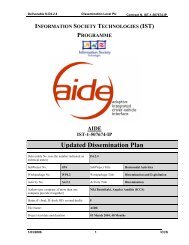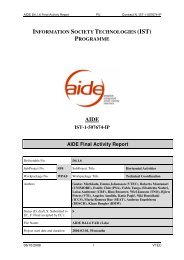download deliverable - AIDE
download deliverable - AIDE
download deliverable - AIDE
Create successful ePaper yourself
Turn your PDF publications into a flip-book with our unique Google optimized e-Paper software.
Deliverable D4.2.1 Dissemination Level PU Contract N. IST-1-507674-IP<br />
3.5. The European Statement of Principles: Current Status and next steps<br />
Presenter: Valerie Moutal, EC/IST<br />
In-vehicle driver information and support systems (eg navigation, communications,<br />
collision warning) need to be carefully designed so that they do not distract the driver and can<br />
properly support the driving task. In December 1999 the European Commission (EC) adopted<br />
the European Statement of Principles (ESoP) in acknowledgement of the importance of<br />
Human-Machine Interaction (HMI) safety for in-vehicle telematics. In recommending<br />
adherence to the ESoP, the EC urged the European motor manufacturing and in-vehicle<br />
information systems supply industry to comply with the ESoP which outlined a number of<br />
basic safety requirements concerning the design of, and driver interaction with, in-vehicle<br />
information, communication and entertainment systems. Member States were invited by the<br />
EC to take steps to encourage industry to comply with the ESoP and report back on the<br />
awareness of ESoP within the industry and the degree of compliance to the ESoP by the<br />
industry by December 2001. Only a handful of Member States reported back. In recent<br />
months an EC e-Safety Working Group has identified the potential safety benefits of driver<br />
information and assistance systems for the driver and has recommended that HMI issues be<br />
given urgent attention. An Expert Group for HMI has therefore been set up under the e-Safety<br />
initiative. This Expert Group will effectively address the HMI safety issues as the ‘next steps’<br />
to the outcome of the EC ESoP exercise.<br />
The principles, 35 in total, are divided into six categories:<br />
• Overall design principles<br />
Since there are only three of them, they can be quoted here in full in order to get an idea of the<br />
principles format and content:<br />
- ‘The system should be designed to support the driver and should not give rise to potentially<br />
hazardous behaviour by the driver or other road users.’<br />
- ‘The system should be designed in such a way that the allocation of driver attention<br />
to the system displays or controls remain compatible with the attentional demand of<br />
the driving situation.’<br />
- ‘The system should be designed so as not to distract or visually entertain the driver.’<br />
• Installation principles<br />
Five principles deal with the way in which in-vehicle systems should be positioned and fitted.<br />
It is not so much driver ‘active’ distraction as the possible obstruction of the driver’s view and<br />
of controls and displays that is the subject here.<br />
• Information presentation principles<br />
This category, which contains five principles, together with the next two, forms the core<br />
of the statement. Several of the principles included in it deal explicitly or implicitly with<br />
driver distraction.<br />
• Principles on interaction with displays and controls<br />
This category deals with the ‘hardware’ of interacting with the in-vehicle system.<br />
• System behaviour principles<br />
25/07/2005 18 ICCS







